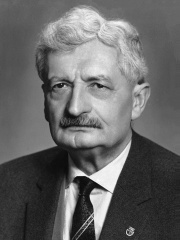

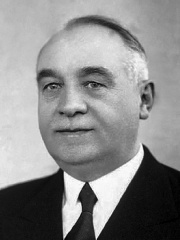
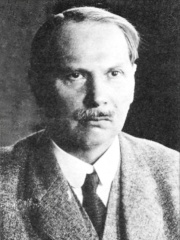
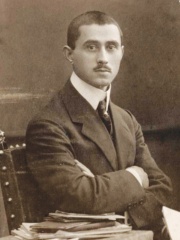
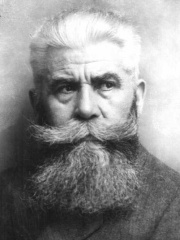
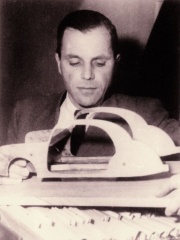
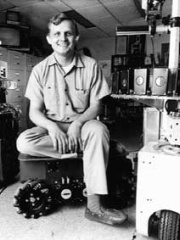
The Most Famous
ENGINEERS from Austria
Top 10
The following people are considered by Pantheon to be the top 10 most legendary Austrian Engineers of all time. This list of famous Austrian Engineers is sorted by HPI (Historical Popularity Index), a metric that aggregates information on a biography's online popularity. Visit the rankings page to view the entire list of Austrian Engineers.

1. Hermann Oberth (1894 - 1989)
With an HPI of 70.04, Hermann Oberth is the most famous Austrian Engineer. His biography has been translated into 51 different languages on wikipedia.
Hermann Julius Oberth (German: [ˈhɛrman ˈjuːli̯ʊs ˈoːbɛrt]; 25 June 1894 – 28 December 1989) was an Austro-Hungarian-born German physicist and rocket pioneer of Transylvanian Saxon descent. Oberth supported Nazi Germany's war effort and received the War Merit Cross (1st Class) in 1943.

2. Alexander Wienerberger (1891 - 1955)
With an HPI of 65.89, Alexander Wienerberger is the 2nd most famous Austrian Engineer. His biography has been translated into 28 different languages.
Alexander Wienerberger (December 8, 1891 – January 5, 1955) was an Austrian chemical engineer, who worked for 19 years in the chemical industry of the Soviet Union. While he worked in Kharkiv, he created a series of photographs of the massive man-made genocidal famine, the Holodomor (Голодомор) of 1932–1933, which serves as photographic evidence of the mass starvation and deaths of the Ukrainian people committed by Joseph Stalin and the Soviet communist authorities at that time, in their attempt to destroy Ukraine and its people. The famine was the worst and most deadly in the central, southern, and eastern parts of Ukraine.

3. Hans Ledwinka (1878 - 1967)
With an HPI of 63.95, Hans Ledwinka is the 3rd most famous Austrian Engineer. His biography has been translated into 21 different languages.
Hans Ledwinka (14 February 1878 – 2 March 1967) was an Austrian automotive designer.

4. Viktor Kaplan (1876 - 1934)
With an HPI of 63.46, Viktor Kaplan is the 4th most famous Austrian Engineer. His biography has been translated into 25 different languages.
Viktor Kaplan (27 November 1876 – 23 August 1934) was an Austrian engineer and the inventor of the Kaplan turbine.
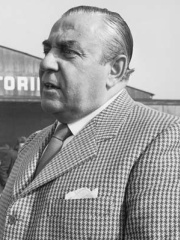
5. Carlo Abarth (1908 - 1979)
With an HPI of 63.06, Carlo Abarth is the 5th most famous Austrian Engineer. His biography has been translated into 18 different languages.
Carlo Abarth (15 November 1908 – 24 October 1979), born Karl Albert Abarth, was an Italian automobile designer. Abarth was born in Austria, but later was naturalized as an Italian citizen; and at this time his first name Karl Albert was changed to its Italian equivalent of Carlo Alberto.

6. Aurel Vlaicu (1882 - 1913)
With an HPI of 60.81, Aurel Vlaicu is the 6th most famous Austrian Engineer. His biography has been translated into 22 different languages.
Aurel Vlaicu (Romanian pronunciation: [a.uˈrel ˈvlajku] ; 19 November 1882 – 13 September 1913) was a Romanian engineer, inventor, airplane constructor, and early pilot.

7. Hanns Hörbiger (1867 - 1931)
With an HPI of 60.43, Hanns Hörbiger is the 7th most famous Austrian Engineer. His biography has been translated into 17 different languages.
Johannes "Hanns" Evangelist Hörbiger (29 November 1860, in Atzgersdorf – 11 October 1931, in Mauer) was an Austrian engineer from Vienna with roots in Tyrol. He took part in the construction of the Budapest subway and in 1894 invented a new type of valve essential for compressors still in widespread use today. He is also remembered today for his pseudoscientific Welteislehre ("World Ice doctrine").

8. Béla Barényi (1907 - 1997)
With an HPI of 58.23, Béla Barényi is the 8th most famous Austrian Engineer. His biography has been translated into 16 different languages.
Béla Barényi (1 March 1907, Hirtenberg, Austro-Hungarian Monarchy – 30 May 1997, Böblingen, Germany) was an ethnic Hungarian engineer from Austria-Hungary, who was a prolific inventor, sometimes even compared to Thomas Edison. Barényi made numerous crash protection inventions, and is therefore regarded as the father of passive safety in automotive design. "The lives of thousands of people have probably been saved thanks to Barényi's work." Barényi is also credited with first conceiving the original design for the German people's car (the Volkswagen Beetle) in 1925, – notably by Mercedes-Benz, on their website, including his original technical drawing, – five years before Ferdinand Porsche claimed to have made his initial version. Barényi was inducted into the Detroit Automotive Hall of Fame in 1994, and nominated for the award of Car Engineer of the Century in 1999. Barényi died in Böblingen, Germany in 1997. A Mercedes advertisement featuring Barényi’s image stated: “No one in the world has given more thought to car safety than this man.” Béla Barényi left a broad record of his inventions to the Technisches Museum Wien in Vienna.

9. Hans Moravec (b. 1948)
With an HPI of 57.57, Hans Moravec is the 9th most famous Austrian Engineer. His biography has been translated into 24 different languages.
Hans Peter Moravec (born November 30, 1948, Kautzen, Austria) is a computer scientist and an adjunct faculty member at the Robotics Institute of Carnegie Mellon University in Pittsburgh, USA. He is known for his work on robotics, artificial intelligence, and writings on the impact of technology. Moravec also is a futurist with many of his publications and predictions focusing on transhumanism. Moravec developed techniques in computer vision for determining the region of interest (ROI) in a scene.

10. Erwin Komenda (1904 - 1966)
With an HPI of 56.60, Erwin Komenda is the 10th most famous Austrian Engineer. His biography has been translated into 15 different languages.
Erwin Komenda (6 April 1904 - 22 August 1966) was an Austrian automobile designer and Porsche employee, and a lead contributor to the design of the bodies for the VW Beetle and various Porsche sports cars. Erwin Komenda was born on 6 April 1904 in Jauern am Semmering. His father, Franz Komenda, was the technical director of the first power station on the Semmering and in Weyer / Enns, where the family relocated in 1913. From 1916 to 1920 he attended a higher technical institute for iron processing in Steyr. From 1920 to 1926 he worked as an automotive designer in the "Wiener Karosseriefabrik" and completed the bodywork design course at Josef Feldwabel in the Vienna Technological Museum of Commerce. From 1926 to 1929 he was a designer in the Steyr works. Here he met Ferdinand Porsche for the first time, who came to Steyr as Technical Director after leaving Daimler-Benz AG. From 1929 to 1931 he was chief designer of the experimental and body development department of Daimler-Benz AG in Sindelfingen. During this time, cars such as the Mercedes-Benz Mannheim 370 K were built with a remarkably weight-saving new design, equipped with Steyr technology from the Steyr XXX: "swinging-axle suspension, independent suspension, braking systems". Also a streamlined small car with rear engine was developed. In November 1931, Komenda joined the engineering office newly founded by Ferdinand Porsche as head of the bodywork design department, which he headed until 1966. Among other projects, he developed the body of the VW beetle. With more than 21.5 million units, the VW Beetle became the best-selling automobile of the 20th century. With graduate engineer Josef Mickl, a Porsche employee specializing in aircraft construction and aerodynamics, Komenda developed the bodywork of the P-Auto Union racing car and Cisitalia racing car. As early as 1946 Komenda began work on the body of the first Porsche sports car. He developed the body of the Porsche 356, various following types and the Porsche 550 Spyder. As a responsible Porsche engineer, he led the Stuttgart-based company into the next generation, accompanying and supervising the bodywork production of the Porsche 901, which was further developed into the 911. One of his latest projects was the development of the plastic body of the 904 race car. Komenda's last phase of life was marked by in-house difficulties with Porsche family members during the development of the Porsche 911. Erwin Komenda died on 22 August 1966. He was an active employee at Porsche until his early, sudden death. His life ended with the development of the Porsche 911.
People
Pantheon has 10 people classified as Austrian engineers born between 1867 and 1948. Of these 10, 1 (10.00%) of them are still alive today. The most famous living Austrian engineers include Hans Moravec. The most famous deceased Austrian engineers include Hermann Oberth, Alexander Wienerberger, and Hans Ledwinka.
Living Austrian Engineers
Go to all RankingsDeceased Austrian Engineers
Go to all RankingsHermann Oberth
1894 - 1989
HPI: 70.04
Alexander Wienerberger
1891 - 1955
HPI: 65.89
Hans Ledwinka
1878 - 1967
HPI: 63.95
Viktor Kaplan
1876 - 1934
HPI: 63.46
Carlo Abarth
1908 - 1979
HPI: 63.06
Aurel Vlaicu
1882 - 1913
HPI: 60.81
Hanns Hörbiger
1867 - 1931
HPI: 60.43
Béla Barényi
1907 - 1997
HPI: 58.23
Erwin Komenda
1904 - 1966
HPI: 56.60
Overlapping Lives
Which Engineers were alive at the same time? This visualization shows the lifespans of the 8 most globally memorable Engineers since 1700.

